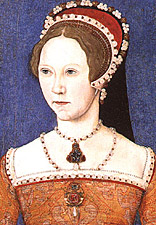I don’t know when it started – I can say
this though, it started long before the sexually explicit Showcase series The Tudors, with Jonathan Rhys Meyers –
but I have this fascination with the history of the Tudors, especially Mary Tudor (aka, Bloody Mary).
My interested with the Tudors may have
actually germinated in late 1980s or early 1990s with the publication of
Margaret George’s The Autobiography of
Henry VIII with Notes by His Fool, Will Sommers: A Novel, which I bought around the time
of publication, but I haven’t read it yet.
It’s on my books-to-read-before-I-die
list.
 |
| Philippa Gregory |
I think my interest in the Tudors climaxed,
so-to-speak, in 2009, when I started reading Philippa Gregory’s The Tudor Court
Novels. It all started with The Other Boleyn Girl, which I couldn’t
put down, once I started reading it.
This is odd because there was a time when I thought Philippa
Gregory was "popular trash,"
the sort of fiction that one finds in Walmart bargain bins. I actually remember seeing
a Philippa Gregory novel in my cousin’s car, years ago, and all I thought, rather snobbishly, when I saw the book in the back
seat, was, 'I thought she [my cousin] was smarter than that.'
There are six books in the Tudor Court
Novels:
 The Constant Princess
The Constant Princess
Copyright: 2005
Read: September 2009
The Constant
Princess is the third book I read and the fourth
published, but in historical chronology, it’s the first book in the series, if
that makes any sense. This is the story
of Catherine of Aragon, Henry VIII’s first and most loyal wife. Her life is one of constantly waiting. On a scale of 1 through 10, this book is
Phillippa Gregory's 5.
 The Other Boleyn Girl
Copyright: 2001
The Other Boleyn Girl
Copyright: 2001
Read: May 2009
This is the book that started it all, literally. This book made Philappa Gregory a literary superstar. It’s the story of Anne Boleyn as seen through
the eyes of her sister, Mary. On scale
of 1 through 10, this book is Philappa Gregory’s 10. This is the book by which all other Philippa
Gregory books will judged against. I'm
no historian but I would wager that this book resurrected Mary, the other Boleyn girl, to history.
The Boleyn Inheritance
 Copyright: 2006
Copyright: 2006
Read: July 2009
On the 1 through 10 scale, this book is Philappa
Gregory’s 1 or 0.75. Like the sexually
explicit Showcase series The Tudors, this book is soft-core porn. It concerns three women: Anne of Cleves, Henry VIII's third wife and lived, Katherine Howard, the fourth wife and
was hung, and Jane Rochford, the wife
of George Boleyn, brother to Anne Boleyn--both whom are dead. Henry VIII dies in this book--the pig bastard.
 The Queen's Fool
Copyright: 2003
The Queen's Fool
Copyright: 2003
Read: July 2013
On the 1 through 10 scale, this book is Philappa
Gregory’s 8. This is the story of Mary
Tudor, the first queen of England.
Mary's story, like her mother's story, Catherine of Aragon, is tragic, even pathetic. This book also contains some extrasensory
perception events, but it's done tastefully, I think. Will Sommers, as noted above, appears in this
book. I would love to see this book made
into a BBC television miniseries.
Copyright: 2004
Not Read
As I just finished reading The Queen's Fool, I'm going to hold off for a while before I read another Philippa
Gregory novel. I don't want to get bored of
her. This book, by the way, is about Elizabeth.
 The Other Queen
The Other Queen
Copyright: 2008
Not Read
And this book is about Mary, Queen of the Scots. After The
Autobiography of Henry VIII with Notes by His Fool, Will Sommers: A Novel, the next Margaret George novel released
was Mary Queen of Scotland and Isles. It was published in 1992. Mary
Queen of Scotland and Isles, like The
Other Queen, is in my library and, I should note, on my books-to-read-before-I-die list.
SPECIAL MENTION
Mary Tudor: The First Queen
by: Dr. Linda Porter
Copyright: 2007
This book is "academic" and is concerned
with the life of Mary Tudor. The author,
an historian, provides a sympathetic understanding of "Bloody Mary" and
her reign. Oddly, I read this book a lot
quicker than I read the Philippa Gregory novels and on the Philippa Gregory scale
(as noted above), I would give this book a 10.
Personally, I have this connection to people with tragic lives, like
Nixon for instance, which may account for why Mary Tudor fascinates me.
 |
| Princess Mary by Master John |
Generally speaking, I’m impressed with
Philippa Gregory’s books. Her novels are
fun to read and despite having a Ph.D in 18th Century Literature,
one should read Philippa Gregory the way one watches Hollywood movies that
claim to be a true stories: you aren’t
watching (or reading) a documentary.
NOTE:
The White Princess, which is part Philippa Gregory’s The Cousins’ War
Series has been made into a television miniseries. I look forward to watching it.





































